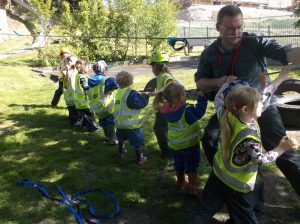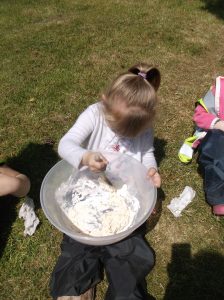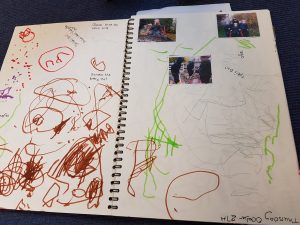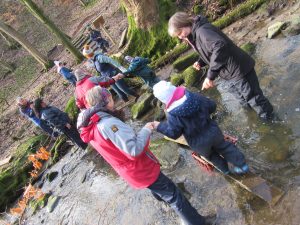This follows on from Early Years Outdoors Pt.1 where I consider why I do this type of work and what I think some of the benefits are. In this piece my intention is to begin to explain how these sessions can be a part of a broader early years provision. It also offers insight into how the Early Years Curriculum works for those that perhaps don’t know. If you do know how that hangs together, I welcome the chance to discuss it all with you. You can reach me on email here on Twitter & Facebook
So, what about the EYFS…
The Early Years Foundation Stage has four guiding principals. They are:
1.Every child is a unique child, constantly learning and can be RESILIENT, CAPABLE, CONFIDENT and SELF ASSURED.
2.Children learn to be STRONG and INDEPENDENT through POSITIVE relationships
3.Children learn and develop well in ENABLING ENVIRONMENTS, in which their EXPERIENCES respond to their individual needs and there is a strong partnership between all the adults involved
4.Children develop and learn in different ways and at different rates.
I have highlighted in capitals the bits I believe the outdoors, in whatever form, can really bring something different to the party, beyond what a classroom can deliver. As four lines, even out of context, they make a lot of sense. Who wouldn’t want their daughter or son to fit into or at least identify with those statements?
Those guiding principals sit across seven areas of learning usually split as Prime and Specific. The Prime: Personal, Social & Emotional Development, Communication & Language and Physical Development. The Specific areas being – Literacy, Mathematics, Understanding the World and Expressive Arts & Design. Now it doesn’t take much creativity to make all of those fit into or apply to an outdoor setting! Each of these areas contains a number of statements that early years professionals use to monitor a childs progress against the expectation of their age, for example in Communication and language somewhere between the age of 30 and 50 months, a child will begin to:
-Listens to others one to one or in small groups, when
conversation interests them.
-Listens to stories with increasing attention and recall.
-Joins in with repeated refrains and anticipates key events and
phrases in rhymes and stories.
-Focusing attention – still listen or do, but can shift own
attention.
-Is able to follow directions (if not intently focused on own
choice of activity).
The Early Years Practitioner will, through casual and planned observations note down when a child consistently carries out these characteristics or behaviours. This takes planning of course to create situations and mechanisms to initially provide the opportunity to first learn then develop and ultimately see that behavior consistently – “listens to stories…” is the obvious example. Some of that happens more naturally such as with toileting/personal care skills or the way a child eats.
This format is repeated over each specific area and age range from birth to 60 months. It is a massive task each practitioner has with each child in their charge typically up to 10 children in a key group- theirs is not an easy job!
Here are a few more, with extracts highlighted that I believe the outdoors lends itself to. This list is not even close to being definitive.
1.Communication and language. “rich language environment” “speak and listen in a variety of situations”
2.Physical development. “develop co-ordination, control and movement” “importance of physical activity”
3.PSE. “Positive sense of self” “confidence in own abilities”
4.Literacy. Physical development – writing. “wide range of reading materials”
5.Maths. Counting, shapes, spaces and measures
6.Understanding the world. “opportunity to explore, observe and find out about people, places technology and the environment
7.Expressive arts and design. “explore and play with a wide range of materials” “variety of activities in art, music, movement, dance, roleplay and DT”

Where the outdoors and the odd adventurous activity fits in and my take on it particularly is it offers most children something new, different and outside their usual sphere of nursery and bright coloured plastic experience. This also provides the Early Years Professional the opportunity to focus on observing entirely natural behavior as the child reacts to me and the activity, it frees up the professional to make the observation, when usually they are delivering the activity and trying to observe at the same time, which is a tall order to do both to the high standard they would wish to. The children are involved in how that session pans out: the timing, the structure, the activity or task itself. Every session has a plan agreed in advance, but believe me every session is very different, as every child is unique and so each responds differently to the same stimulus, which then creates different reactions from me and the practitioners and teaching staff involved. It is astonishing how with one plan for each of the ten key worker groups in a nursery, all ten are unique. Even the simple act of reading a story outside in the sun or under canvass, or in a willow tunnel, perhaps having just experienced something the characters in the story have, takes on a different and deeper meaning to each child if we have just been balancing like Jess in “The Wild Woods” or helping Owl Mummy find her babies and build a nest (Owl Babies) or pitching a tent like Maisie in “Maisie Goes Camping”. Balancing different fruits on our heads like Handa in “Handa’s Surprise”. The list goes on.

I am told after sessions that what we have achieved or created impacts on the children’s play back in nursery, there is frequently imaginative play reflecting what we have done or directly recreating it for several days and weeks afterward. Coupled with art work and drawings helping recall and further self expression (‘how did that make you feel?’) the opportunities for following up those outdoor sessions are full of potential themselves in meeting EYFS statements.

What I want to achieve with every early years session is to offer a range of activity which supports the child in their development through opportunity they may otherwise not get and offers the childcare professional the chance to view their charges in a different light and perhaps gives both some different experiences to broaden horizons.
A note on being a bloke. It helps! In the Early Years world us chaps are thin on the ground. There is no getting away from the fact that being male in this environment is a little quirky and offers the children a very different approach and delivery to just about everything I ask of them. if nothing else it comes in a different tone! There is no conclusion there, it just is.

A common question in these activities and one that every Head Teacher/Nursery Manager is keen to ask is one of risk. I will look at risk and most importantly managing risk in a further piece to follow. Part three shall be its name….
